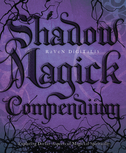By Melanie Harris
Shadow Magick Compendium: Exploring Darker Aspects of Magickal Spirituality, by Raven Digitalis
Published by Llewellyn Publications, September 2008
ISBN: 9780738713182
Those in a spiritual rut, prepare to be wrenched out. Going where fluffy bunnies fear to tread, Raven Digitalis takes us on a breathtaking walk in the dark in Shadow Magick Compendium: Exploring Darker Aspects of Magickal Spirituality (Llewellyn Publications, 2008). Looking into the shadows can help us progress spiritually, and this second title by the author of Goth Craft (Llewellyn Publications, 2007) is a vehicle to do just that.
This is NOT a book about “bad” magick; the focus here is on spiritual balance and magickal development. Shadow Magick Compendium is a book about acknowledging and examining the dark side of things, those characteristics of self and nature and life and death that are more often feared, misused, or ignored than they are understood.
There are lots of interesting things lurking in the darkness, and this book is divided into five sections to take you there: The Internal Shadow, The External Shadow, The Astral Shadow, The Shadow of Nature, and the Shadow of Society. Each chapter presents an overview of the particular aspect of shadow, and offers practical exercises to apply the knowledge in your own life. It’s a good mix of solid information, progressive ideas, and creative techniques – one of the signature flairs of this author.
Despite his hip-sounding name, young age (mid-twenties), and modern eclectic Neo-Pagan identity, Raven Digitalis hearkens back to the old school days of magick, a time when well-reasoned creativity, logic, research, practicality, tradition, and plain old studying were a bit more often valued in magickal circles than they are today. This kid does his homework, and even seasoned occultists and witches will pick up new perspectives and new modes of magick from Shadow Magick Compendium, while beginners won’t be, dare I say, left in the dark.
Chapter 1, The Internal Shadow, takes a look at negative behavior patterns and offers tools for getting out of them, including a self-evaluation checklist to discover just where your imbalances and repressed feelings might lie. The checklist is frank and cuts to the core; readers evaluate statements such as, “I stress about my obligations and requirements more than I should,” and, “I tend to manipulate other people,” to see if they feel the statement applies to them. This sort of soul-searching is essential, Raven teaches, for anyone hoping to spiritually progress. The book states, “We can only change the external world by transforming the internal; both simultaneously co-create each other. Every single one of us has behavioral and perceptual patterns that somehow hinder our full spiritual development – or else we wouldn’t be here!”
A ritual meditation for “Purging the Shadow” is given, followed by a positively fascinating tour of the mystic experience and the many ways it can be achieved. Here, well-researched facts about the Qabalah, Sufism, and other methodologies that can lead to the mystic experience are presented.
Chapter 2 discusses the external shadow, which encompasses godform assumption and invocation, fasting, the art of creating sigils, and more. The fasts are particularly interesting, ranging from a traditional food fast to a very modern fast from technology. “Eliminating technology from one’s daily operation is, like all sacrifices, both difficult and rewarding,” writes Raven. “Such an endeavor illuminates our modern lifestyle, and reminds us that humans operated without electronic technology for aeons.” He encourages readers to design their own structure for the fast, deciding how long and how strict the fast will be.
Chapter 3 is about astral projection, power animals, and other elements of the astral shadow. This chapter includes an essay by Estha McNevin on spirit guides. Estha is Raven’s priestess and she is the co-founder of their shadow magick tradition, Opus Aima Obscurae. Estha explains the concept of spirit guides and guardians intelligently, imparting a credibility that is often not present in discussions about the subject.
Chapter 4 is dedicated to the Shadow of Nature, and teaches the reader how to best use the power of the dark moon, eclipses, and the shadier portions of the wheel of the year. This chapter also contains an invaluable mini-herbal, a guide to the magical attributes and properties of “dark” herbs, those plants that are particularly well-suited for shadow magick.
Chapter 5, the Shadow of Society, is bold and frank. Raven speaks about problems within the occult/magickal scene, and he also deconstructs many of the myths that often surround the Burning Times, a.k.a., the era of burn ‘em at the stake witch hunts. His honesty, objectivity, and adherence to facts is refreshing.
There is so much more that this book discusses, and so much more depth, analysis, and practical application offered on the topics I did mention. For anyone with an interest in spirituality or magick, Shadow Magick Compendium is truly fascinating.
